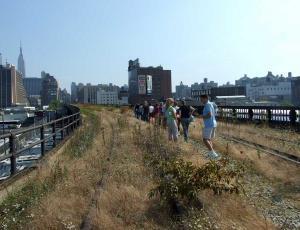Section 2 of the phenomena known as the High Line park, in New York City, is to be opened tomorrow. This follows on from the huge success of section 1 which opened two years ago on the 9th June 2009. Section 2, costing $153m, stretches 10 blocks from 20th Street in Manhattan’s West Chelsea, to 30th Street. This will more than double the existing length of the park.

High Line In Use As Railway Line
Section 3, the final section of the High Line, is a number of years away yet but it is rumoured that it will become the front door of this linear park. When completed this linear park will be one and a half miles long.
The High Line is essentially a linear park constructed on a disused railway viaduct. The scheme consists of a linearly paved surface with planting to its edges. Former elements of the railway line have been incorporated into the design, including the railway track. Along the length of the park there is seating and places to view the city from the elevated position. The landscape architect responsible for this project is James Corner Field Operations, working with architects Diller Scofldio + Renfro. The Dutch horticulturalist Piet Oudolf was consulted for advice on planting design.

High Line Disused
Since section 1 has opened it has been a huge success, with two million people visiting the park last year alone. As a consequence retailers have been attracted to the area and have cashed in on this growth in footfall to this area. With the opening of section 2 there will be more opportunities for vendors, riding on the back of what is already a successful scheme.
The High Line is a public park run by a non-profit organisation, Friends of the High Line. Donors to this organisation include Estee Lauer, Levi’s and property developers. The board of directors for the organisation reads like a who’s who of arts, real estate and high finance, each having their own reason for being involved.

High Line Public Park
Developers who have an interest in the vicinity of this park have understood donations to this public facility are a sound investment. Numerous new developments have popped up adjacent to sections 1 & 2 of the park, many explicitly promoting their connection to the High Line.
Friends of High Line co-founder Robert Hammond said ‘Normally, the farther you get from the subway the less expensive the housing is. But the closer you are to the High Line, the farther you are from the subway, and still, the closer the apartments are to the High Line, the more expensive they get.
According to The New York Times on the 5th June 2011 ‘preserving the High Line as a public park revitalised a swath of the city and generated $2 billion in private investment surrounding the park’. That is with an investment from the city of only $112m in the park itself.
This suggests to me that investing in our public realm, even in times of austerity makes sound economic sense.

